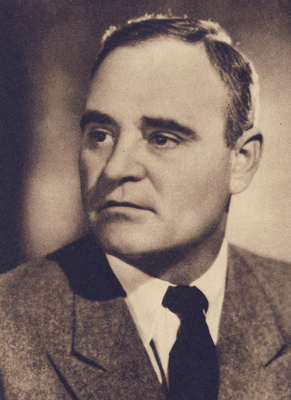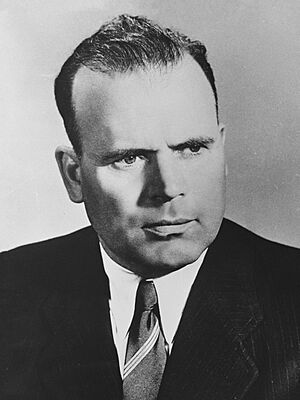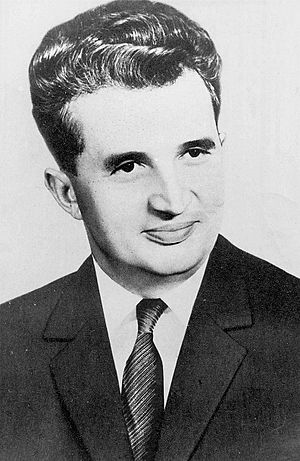State Council of Romania facts for kids
The State Council (Romanian: Consiliul de Stat) was an important group in the government of Romania from 1961 to 1989. Think of it as the country's main leader, but it was a group of people, not just one person. This group acted as the head of state (the top representative of the country) until a single President was created in 1974.
Contents
What the State Council Did
Early Years: 1961–1974
The State Council was created in 1961. It took the place of an older group called the Presidium of the Great National Assembly (which was like Romania's parliament).
At first, the State Council had a president, three vice presidents, and thirteen other members. By the end of the Communist era, it had a president, four vice presidents, a secretary, and 15 members.
The State Council was chosen by the Great National Assembly from its own members. It was supposed to be in charge when the Great National Assembly wasn't meeting. Even though the State Council was supposed to be under the Great National Assembly, in reality, most of its members were also important leaders in the Romanian Communist Party. This meant the Party had a lot of control.
The State Council had many important jobs. Some of these jobs were always theirs, like:
- Setting dates for elections.
- Approving agreements with other countries (called treaties).
- Organizing public votes (referendums).
- Choosing and removing the head of the armed forces and other government leaders.
- Deciding who could become a Romanian citizen, offering protection to people (asylum), and forgiving certain crimes (amnesty).
- Representing Romania to other countries.
- Giving out military ranks, awards, and special titles.
When the Great National Assembly wasn't meeting, the State Council could also make rules that were like laws. If the Great National Assembly didn't approve these rules later, they would be canceled. In special situations, the State Council could even control the country's money plan, choose or remove government ministers and judges, call up the army, and declare war. Because the Great National Assembly didn't meet very often, the State Council's decisions usually became law.
All decisions by the State Council were supposed to be made by the whole group. However, outside of Romania, the president of the State Council was seen as the country's main leader. When the leader of the Communist Party was also the State Council president (like Gheorghe Gheorghiu-Dej and Nicolae Ceaușescu), their real power came from leading the Party, not just from being president of the State Council.
Changes in 1974
In 1974, big changes happened. The job of the State Council's president became much more powerful. It was upgraded to a full-time position called the President of the Republic.
The President of the Republic automatically became the president of the State Council. This new President could make decisions on many things without needing the whole State Council's approval. The President also took over several powers that the State Council used to have, such as:
- Handling relationships with other countries.
- Choosing and removing government ministers and heads of government agencies.
When the Great National Assembly wasn't meeting, the President could even choose or remove the head judge of the Supreme Court and the chief prosecutor without asking the State Council. The State Council also lost the power to grant citizenship, asylum, or choose the supreme commander of the armed forces. It also couldn't grant amnesty when the Great National Assembly was meeting.
After 1974, the State Council became much less powerful. Nicolae Ceaușescu, who was both the leader of the Communist Party and the President of the Republic, often made decisions by himself. He took over many of the State Council's powers. Because he had so much control over the country, no one dared to disagree with him.
Presidents of the State Council
| No. | Name | Portrait | Born–Died | Took office | Left office | Party | |
|---|---|---|---|---|---|---|---|
| 1 | Gheorghe Gheorghiu-Dej | 1901–1965 | 21 March 1961 | 19 March 1965 | PMR | ||
| 2 | Chivu Stoica | 1908–1975 | 24 March 1965 | 9 December 1967 | PMR/PCR | ||
| 3 | Nicolae Ceaușescu | 1918–1989 | 9 December 1967 | 22 December 1989 (ex officio from 28 March 1974) |
PCR | ||
Vice Presidents of the State Council
(Romanian: Vicepreşedinte al Consiliului de Stat)
| Name | Took office | Left office | Party | Name | Took office | Left office | Party | Name | Took office | Left office | Party | Name | Took office | Left office | Party | Name | Took office | Left office | Party | |||||
|---|---|---|---|---|---|---|---|---|---|---|---|---|---|---|---|---|---|---|---|---|---|---|---|---|
| Ion Gheorghe Maurer | 1961 | 1967 | PCR | Ştefan Voitec | 1961 | 1965 | PCR | Maria Paretti | 1961 | 1966 | PCR | Avram Bunaciu | 1961 | 1965 | PCR | Vacant | ||||||||
| Constanţa Crăciun | 1965 | 1969 | PCR | Vacant | ||||||||||||||||||||
| Emil Bodnăraş | 1967 | 1976 | PCR | Manea Mănescu | 1969 | 1972 | PCR | Ştefan Peterfi | 1967 | 1978 | PCR | |||||||||||||
| Miron Constantinescu | 1972 | 1974 | PCR | |||||||||||||||||||||
| Vasile Vâlcu | 1974 | 1974 | PCR | Ştefan Voitec | 1974 | 1984 | PCR | |||||||||||||||||
| Vacant | Emil Bobu | 1975 | 1979 | PCR | ||||||||||||||||||||
| Maria Ciocan | 1980 | 1985 | PCR | Petru Enache | 1980 | 1987 | PCR | Gheorghe Rădulescu | 1979 | 1989 | PCR | Ilie Verdeţ | 1982 | 1982 | PCR | |||||||||
| Vacant | Vacant | Maria Ghiţulică | 1985 | 1989 | PCR | Manea Mănescu | 1983 | 1989 | PCR | |||||||||||||||




